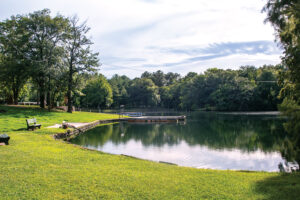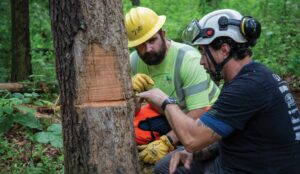










On a warm summer day at Fort de Chartres in Randolph County, two Native Americans clad in breechclouts and little else wandered along an avenue of tents. At a cookfire in front of one of those tents, a bearded woodsman wearing a mixture of linsey-woolsey and buckskin and sharpening a tomahawk discussed the prospects of the St. Louis Cardinals with a 20-something-year-old man in khaki shorts and a T-shirt emblazoned with the team’s logo.
Elsewhere on the grounds, a vendor in her period frock, apron and mobcap spoke 18th-century-style to a potential customer trying on bonnets. Nearby, an animated conversation took place between a French soldier in a tricorn hat and long green waistcoat, a Highland Scot in a resplendent scarlet regimental coat and kilt, and a middle-aged man in a polo shirt and jeans.
The sound of drums and flutes filled the air as the French marines of his most Christian Majesty Louis XV marched through the gatehouse and onto the fort’s parade ground. This was the 53rd Annual Fort de Chartres Rendezvous, and it mixed the modern day with the 1700s.
This “Rendezvous,” which occurs each June at the recreated French fort Fort de Chartres, is a gathering of reenactors, black powder aficionados, merchants and traders in 18th-century reproductions and memorabilia. It is an opportunity for visitors to sample living history, gain an understanding of mid-18th-century life in southern Illinois and learn the background of Fort de Chartres — a story of resilience and rebirth.
That story began with the long rivalry between France and England — a rivalry that was brought to North America in the 17th century and grew steadily until it culminated in the French and Indian War (1754-1763). By 1720, the English established settlements along the Eastern Seaboard from what is now Maine to South Carolina, while the French were in Canada, what is now Louisiana and coastal Alabama, and were pushing up the Mississippi.
It was a logical move that would create a riparian highway between their two colonial holdings to give them better access to the fur trade and the rich bottomlands of the Mississippi floodplain, and act as a roadblock to England’s westward expansion.
This plain, encompassing about 175 square miles, begins near the mouth of the Kaskaskia River and stretches north to around Alton. It was, and is, excellent land for farming, and the French hoped to establish a strong and lasting presence there.
So, in 1720, they built a fort about 20 miles north of the mouth of the Kaskaskia River and named it Fort de Chartres in honor of the son of the Duke of Orleans, the regent of France during the minority years of Louis XV.
The newly established fort was not the one you see today, with its imposing gatehouse and stone walls. It was instead a wooden palisade with bastions at the corners, somewhat like the wooden forts so familiar to us from countless movies and TV shows. In 1722, colonists from Canada established the nearby town of Prairie du Rocher.
By 1725, the periodic flooding of the Mississippi had severely impacted the fort, and the decision was made to rebuild some distance away yet remain on the floodplain. Again, due to its abundance and cost, wood was the material of choice. This incarnation of Fort de Chartres lasted for well over a decade before it, too, fell victim to the river. Around 1747, the garrison moved to Kaskaskia, and the site fell into further disrepair.
The administration debated between building a permanent fort at Kaskaskia and rebuilding Fort de Chartres, but nothing was decided until the political situation changed. In the 1750s, tensions between Britain and France ultimately led to the French and Indian War. The French decided to build new forts and strengthen existing ones from Louisiana Territory to Canada.
Once again, Fort de Chartres was rebuilt and relocated a short distance from the previous site. However, this time it was built of stone, which was quarried from the limestone bluffs only a few miles from the fort.
Construction began in 1753, and by the end of 1754, the structure was complete enough to allow occupation. According to the records, the new fort walls, 15 feet high and nearly 3 feet thick, enclosed an area of approximately 4 acres. Inside the walls were barracks, administrative buildings, a powder magazine and a chapel. Ironically, this structure that was built to exacting standards to withstand even light artillery would never suffer attack or siege.
In 1763, the French and Indian War ended in the defeat of France and the loss of all territory in North America. The French ceded Louisiana and everything west of the Mississippi to the Spanish. The British acquired all of Canada and the Illinois Territory.
In late 1765, the British took formal possession of Fort de Chartres. In 1772, the garrison withdrew to Kaskaskia, and soon after the fort once again fell victim to the river, which swept away a bastion and a wall. Over the next several decades, periodic flooding, neglect and the fact that the locals saw it as a convenient place to gather stone for their own construction projects, all contributed to the dismemberment of the fort. By the early 1900s, the only remaining structure was the powder magazine, and it was in a sad state of repair.
In 1913, the state of Illinois purchased the site, and in 1917, the powder magazine, thought to be the oldest existing European structure in Illinois, was reconstructed. In the 1920s, the original building and wall foundations were exposed. 1928 saw the construction of a combination office and museum on the foundation of the King’s Storehouse. In 1936, the “Guards House” was reconstructed, and the Land Gate, the iconic structure that symbolizes Fort de Chartres, was rebuilt on its original site.
In 1966, the site was placed on the National Register of Historic Places and recognized as a historic landmark. In 1989, portions of the wall were rebuilt on the original foundation and additional structures were “ghosted” in wood. To further enhance visitors’ understanding of fort life in the mid-18th century, additional features such as a bake oven, kitchen garden and a shed constructed in the 18th-
century French poteaux-sur-sol (post and sill) method were added.
The shifting course of the Mississippi and the building of levees meant that flood damage was less of an issue, but there were threats of a different nature.
In 2015, the site manager of 45 years was retiring, the fort faced staffing issues, buildings and walls were deteriorating, and a looming state government budget impasse, which came to pass in 2016, meant deep cuts in the state’s support for historic sites. Enter Jason and Jennifer Duensing.
“There was a group, Les Amis du Fort de Chartres (Friends of Fort de Chartres), they were originally established in the 1970s, but by 2015, they weren’t active at all,” Jason explains. “My wife and I saw all the issues facing the site, and we saw a need for a support organization to help care for the place, help raise funds and coordinate special events. So, we approached the state.”
For Jason, Fort de Chartres’ significance goes beyond history and community. “My dad, Darrell Duensing, was the site manager from 1971 to 2015, so I grew up there. Lots of kids say their father built them a fort in the backyard, but my backyard was a fort,” he laughs.
With the blessing of the state, the Duensings renewed the group’s 501(c)(3) charter, revamped the group’s structure, started a membership drive and almost immediately confronted their first challenge.
In 2016, the state budget impasse became a reality. Les Amis stepped in and, working in concert with other fort support groups, raised enough money to fund that year’s special events. In 2020, they sought to raise $100,000 for repairs to the fort and were able to reach their goal by September 2021.
Today, with Jennifer and Jason as president and vice president, respectively, Les Amis has approximately 300 members, many from other states whose visit to the fort inspired them to be a part of its preservation.
As membership has grown, so has the role of Les Amis. Jason says, “The state maintains responsibility for the day-to-day operation, but we provide costumed interpreters, manage the fundraisers for maintenance projects, and we manage all the special events, finding sponsors, coordinating with vendors and participants, and we work closely with the other support groups. In fact, many members of other groups are also members of Les Amis and vice versa, so putting on these events is a community affair.”
Although the annual rendezvous in the summer is the biggest event of the year, attracting 15,000 participants and visitors, there is also a winter rendezvous that draws 10,000 people. Other annual events include the Colonial Market Faire in April, an annual black powder shooting event, and an artillery safety school. Fort de Chartres is the Midwest site for said school that certifies reenactors who fire cannons. A recent addition to the growing list of events is a monthly demonstration, Art de Vivre (art of living), designed to expand understanding of day-to-day 18th-century life in the fort and the surrounding communities.
While Fort de Chartres is the most visible, it is by no means the only remnant of the French presence in southern Illinois. In 1974, a 22-square-mile section known as the French Colonial Historic District was enrolled on the National Register of Historic Places.
In addition to Fort de Chartres, the district includes the remains of Fort Kaskaskia, the Pierre Menard Home, other houses in Prairie du Rocher and several Native American archaeological sites.
Fort de Chartres and the other sites in the district not only have cultural and historical significance, they have an economic impact
on the area, hosting about 55,000 visitors annually and adding around $6 million to the area’s revenue stream.
More than 300 years after its founding, Fort de Chartres still stands, and thanks to groups such as Les Amis Du Fort de Chartres and the Fort de Chartres French Marines, it offers visitors not only a look at monuments of stone but also a glimpse of living history.









